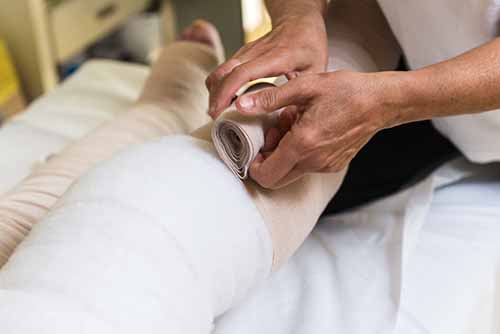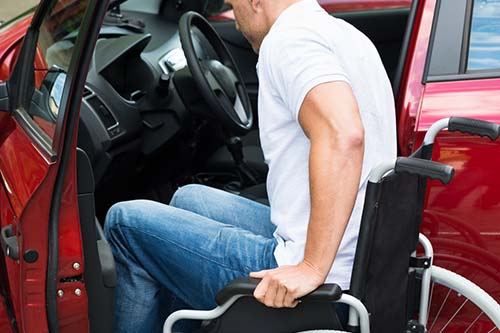Exercise with Lymphedema of the Leg
I am writing this article from two points of view, as an experienced fitness trainer / strength coach who has studied health issues for many years and as a patient who suffers with lymphedema of the leg daily. I have been able to maintain my lymphedema pretty well, but that is because I have done extensive reading on the subject, I listened to my doctors, and I have extensive knowledge of exercise. It is on my mind every day, at almost every moment because it takes great effort to maintain properly. I have included the description of lymphedema below.
Lymphedema is a difficult thing to deal with and must be maintained all day long, every day. There is no cure for lymphedema. I have had lymphedema in my leg since my 1991 cancer surgery. I went from being a gymnastics coach and fitness trainer who exercised daily to being bedridden after my surgery as a result of the lymph nodes being removed along with the cancer. My life changed drastically, but I went back to work and learned how to maintain it as soon as possible. Several doctors told me that I would be bedridden for the rest of my life and that I would never work again. That was in 1991.
So, what is lymphedema? Here is the definition by the National Lymphedema Network…
“Lymphedema is an accumulation of lymphatic fluid in the interstitial tissue that causes swelling, most often in the arm(s) and/or leg(s), and occasionally in other parts of the body. Lymphedema can develop when lymphatic vessels are missing or impaired (primary), or when lymph vessels are damaged or lymph nodes removed (secondary).
When the impairment becomes so great that the lymphatic fluid exceeds the lymphatic transport capacity, an abnormal amount of protein-rich fluid collects in the tissues of the affected area. Left untreated, this stagnant, protein-rich fluid not only causes tissue channels to increase in size and number, but also reduces oxygen availability in the transport system, interferes with wound healing, and provides a culture medium for bacteria that can result in lymphangitis (infection).”
So, what types of exercise can a lymphedema patient perform? That depends on the patient and whether they have medical clearance to exercise. Once cleared for exercise, the best exercise to reduce the leg swelling is swimming because the person is horizontal, in motion, and performing a non-impact movement. The second best exercise for a person with leg lymphedema is riding a recumbent bike. It is also non-impact, it’s a steady motion, and the legs are elevated slightly.
If the patient is in good physical condition otherwise and they have the lymphedema under control (as much as possible) they can use the elliptical machine. That is, if they can tolerate it from a fitness and medical standpoint. Make sure the lymphedema patient has permission from their doctor to perform exercise, especially an intense exercise such as the elliptical. Keep the person with lymphedema OFF THE TREADMILL. Walking and running cause the leg swelling to become MUCH worse because they are high impact. Picture someone putting ice cream into an ice cream cone and then packing it in. The swelling becomes dense, packed in if not maintained properly. The more severe, the more difficult it is to deal with.
In my experience, it can take an hour with the leg elevated before the swelling even BEGINS to go down and several days or weeks for it to completely drain. People with lymphedema should be wearing their compression stocking if their doctor prescribed it and sleeping with her legs elevated every night, unless their doctor has told them otherwise. It is important to stay in motion and to only perform non-impact exercises. For example, squats are often better than walking lunges for someone with lymphedema. The walking lunge is an impact exercise. Do NOT encourage a person with leg lymphedema to participate any exercise classes that include impact exercises. If they are in good shape the spin classes will keep the circulation going and help will lose or maintain a healthy body weight. It’s all about keeping the body in motion without ANY impact exercises.
Keep in mind that of the lymphedema is from a new surgery the patient MUST be cleared to begin exercise because if they begin to exercise before the doctors allow them to exercise they will cause problems with the lymphatic system. My doctors told me the swelling from the surgery would never go down if I started to exercise too soon and that I would cause permanent damage. I was told to wait one full year after my surgery before I was allowed to exercise my legs. I waited 10 months and couldn’t stand it any longer. I HAD to return to exercise because it was what I enjoyed and it was my life. Not being allowed to exercise my legs was extremely difficult for me because I spent a lifetime in the gym. Again, make sure the lymphedema patient has FULL medical clearance to exercise.
Here is something that many people do not know. When a person with lymphedema is not in motion and does not have compression stocking on their leg, they must keep their legs elevated in order to prevent swelling. Something as simple as waiting in line at the grocery store could cause enough swelling to keep a person in bed the next day. The swelling begins in less than a minute, literally, when standing still or sitting without the leg elevated. It is truly a challenge every minute of the day to keep the leg from swelling and those around lymphedema patients must be patient and considerate.
There is plenty of information on lymphedema. It is either primary or secondary. Secondary lymphedema would be caused from something such as a cancer surgery. Mine is secondary because my lymph nodes were removed from my upper thigh on one leg during my cancer surgery. If the lymphedema is not controlled it can end up being elephantitis. Yes, it is a real medical condition and it is very serious. There are lymphedema support groups throughout the USA. The National Lymphedema Network has plenty of information.
\


